Thank you for visiting! By the way… any links on this page that lead to products on Amazon and other stores/partners are affiliate links Aquarium Store Depot earns a commission if you make a purchase.
The Betta Fish for some of us fish keepers was our first experience with a pet fish. It was our introduction to this wonderful world of aquarium keeping. Betta Fish after all has a lot going for them that makes them great pets. They have a great personality and come in a variety of colors. They can exist in smaller tanks and can be relatively hardy as long as the environment is properly cared for.
The main issue with Betta Fish care is that they can be seen as this indestructible fish that can live in just about anything. There are some misconceptions about these fish. Other times, because this is the first time that some of us kept a pet fish, we lack the information and experience to make us successful.
This Betta Fish care guide is written with the purpose to help you with proper care and all the main elements that you need to know about being successful with Betta fish. We will go over proper housing, filtration, heating, decor, diet, and tankmates. We will then put it all together and build out a complete Betta Fish tank.
Key Takeaways
- Betta fish are considered the best beginner fish to start your aquarium journey with
- A 5-gallon aquarium is a minimum needed for a single adult Beta fish
- Betta fish require heaters as they prefer warmer waters
- Betta fish are aggressive to other Bettas but can be bullied by many tropical fish
- There are a vast variety of Betta fish varieties available with many of the rarer variants being better acquired via online stores
A Quick Overview
| Scientific Name | Betta splendens |
| Common Names | Betta Fish, Siamese Fighting Fish |
| Family | Gourami |
| Origin | Thailand |
| Diet | Omnivore |
| Care Level | Beginner |
| Activity | Slow to Moderate |
| Lifespan | 2 – 5 years |
| Temperament | Peaceful (Aggressive to own kind) |
| Tank Level | Middle to top |
| Minimum Tank Size | 5 gallon |
| Temperature Range | 76°-81°F |
| Water Hardness | 5 to 20 DH |
| pH Levels | 6.5 – 8.0 (for most varieties) |
| Filtration/Water Flow | Low |
| Water Type | Freshwater |
| Breeding | Egg-layer |
| Difficulty to Breed | Easy to breed |
| Compatibility | Community tank (with properly selected species) |
| OK, for Planted Tanks? | Yes |
All About Betta Fish Care
The Betta Fish’s scientific name is Betta splendens. They are also known as Siamese Fighting Fish. They originate from Asia and were kept in the past for their fighting nature. They were originally brought into aquariums by locals who caught on rice paddies. They were first imported to the US in 1927. These days, Bettas are primarily kept for their appearance. They have been selectively bred over the years into many different colors and tail types. They are now known as the designer fish in the freshwater hobby.
In the wild, Betta splendens originate from Southeast Asia. They are native to areas that are visited by frequent flooding that will also go through periods of intense droughts afterward. As a result, Betta evolved to become a labyrinth fish. A labyrinth is a fish that has the ability to take in oxygen from the air as well as take oxygen from its grills. Because of this adaption, Bettas have the ability to live outside of water for short periods of time and can breathe the air around them provided they can stay moist. This is the reason why you tend to see Bettas in small containers at the pet store or at home (though I would not recommend this — more on this as we through this post).
Here is a short video on Betta for a quick intro from my YouTube Channel. If you like it, please subscribe for more great videos!
Betta is pronounced Bet-tah. It is very common for newcomers to pronounce it as Bay-tah. They received their name from the ancient Asian “Bettah” warrior clan. They were discovered in Thailand. Their Thai name is Iken Bettah, which is translated as “biting fish.” They are also known as Siamese fighting fish. This name was taken from the word Siam, with Siam being the former name of Thailand. They became very popular in the mid-1800s for their fighting. The fighting sport became so popular that the King of Thailand ended up regulating the sport and taxing it. The sports competitions were actually measured on the fish’s bravery versus the damage they inflicted on their opponent, however.
Male and Female Differences
Males and females are distinctly different when it comes to Betta Fish. The males are generally more colorful with larger fins. Females have shorter fins and are generally duller in color. Male betta fish also tend to have a more torpedo-shaped and larger body. Female betta fish also have an Ovipositor on the undersize of their body. These are tiny tubes that release eggs.

The International Congress (Competitions)
Betta Fish breeding has been very popular over the years with breeders raising some of the most beautiful fish you will ever see in the hobby. In fact, there are competitions for the show Bettas (pronounced Bet-uh) hosted by the International Betta Congress (IBC). Below is a video by DocAquaTV showing an IBC competition in full swing. There is a huge community when it comes to Betta Fish, and seeing these unique-looking and high-quality Betta is a real treat.
I would highly encourage anyone who is passionate about keeping these fish to look into a scientific-based community like the International Betta Congress and maybe even think about joining to deep dive into the Betta world. They offer a lot of benefits like their membership forum and magazine. They have been around since 1967 and really take efforts to bring education and care to Bettas all over the world.
The Major Factors We Need To Know
Now that we know a little bit about the Betta itself and the scientific-based community that supports them let’s talk caring for your betta. We are going to split care for a Betta Fish into the following elements:
- Housing
- Filtration
- Heating
- Decor
- Diet
- Tank Mates
Aquarium (Housing)
I’m going to be very upfront and clear to my readers here with this statement. The best aquarium to start with for a Betta is a 5-gallon tank. That’s correct, 5 gallons. You may be a little taken aback by this statement as you may have visited your pet store and seen many of the “Betta tanks” available for sale. Many of them are badly undersized.
I encourage anyone who is keeping a Betta Fish long-term to invest in a proper five Gallon tank like the the ones offered by Marineland and Fluval. Betta fish live best in a good-sized tank and you want the best for your pet. Invest in the proper tank so your fish can thrive.
We also want to limit the number of male bettas in our aquariums. We should only have 1 male betta in our aquarium unless we are using tank dividers to keep our male bettas separated. Keeping more than 1 male is going to require more than 5 gallons. A 20-gallon tank is best for housing multiple male bettas – 3 to 4 are best for a 20-gallon tank using a 1 betta for every 5 gallons approach.
Aquarium Filtration
Contrary to what you may see in the chain pet stores, Betta fish are not best served in a fish bowl. We want their tanks filtered. This will make it easier to maintain as a fish tank without a filter is going to need a water change every 2 to 3 days. This can get very old fast! We want to make tank maintenance easy to do rather than a major chore. Having proper filtration that houses a lot of beneficial bacteria in your tank will provide a proper nitrogen cycle for your fish tank and for your Betta. This will cut down the number of times you will need to change the water int he tank every month and give your Betta a better environment to grow and thrive. I would recommend a Power Filter if you are not using an aquarium kit or all-in-one tank. The best power filter for a small tank like this is going to be a Penn Plex Power Filter or AquaClear as these companies design power filters at this size and both are adjustable.
When using a power filter, keep in mind that you will still need to protect your Betta. Bettas are known for having delicate fins and being very curious. It’s pretty common for them to get sucked into a filter accidentally or have one of their fins damaged. You will want to dampen the intake of your betta fish filter by putting a sponge over it and adjusting the flow to make it calmer and suitable for the Betta. Bettas prefer calmer waters, and some power filters on the market are designed for a higher gallon-per-hour applications. Adjust it down for your Betta and let them adjust to the flow. Another alternative is to use a low-flow canister like an Aquael Multikani.
Tap Water
Because Siamese fighting fish have labyrinth fish, it is a common misconception to put them in any type of water. While we can use tap water, we want to make sure we have the right type of tap water. Tap water needs to be chlorinated with a proper water conditioner produce like Seachem Prime. Water conditioners like Seachem Prime will remove chlorine, harmful chemicals, ammonia, and nitrite from your tap.
Never stick a Betta in straight tap water. Always make sure to dechlorinate tap water to keep your fish safe.
Tank Heating (Water Temperature)
It may not seem like it because you see many of these Betta for sale at pet stores in bowls or small tanks, but they are actually tropical fish and betta fish need water water. They are most comfortable with water temperatures at 75 to 82 degrees with 78 degrees being your target temperature. I would recommend choosing a quality heater from our Best Aquarium Heaters Reviews post. Eheim heaters are one of the most reliable heaters on the market and are worth a look. Neo Therm Heaters are great as well. They have a smaller footprint that works better with the smaller size of the Betta Fish tanks and will fit in all-in-one tank chambers. Both heaters are accurate up to 1 degree of water temperature, the best in our industry.
I would also highly recommend that you get a Digital Thermometer as a backup for your heater’s internal thermometer. If you have the budget, you can invest in a proper Aquarium Heater Controller for a more foolproof water temperature regulation system.
Tank Decorations
There are two parts of the Decor for Betta’s tank: plants and hardscape (rocks and branches). For plants, specifically artificial plants (I’ll touch on live plants later in the post), we need to be very selective about what we put in our Betta Fish tank.
Silk plants like the Marina Naturals Plant shown above are what we want to purchase for our Bettas. Traditional plastic plants you will see at the pet store are not safe for a Betta Fish. This is because many will contain sharp edges and do not give way if the Betta runs into them. This leads to the delicate fins of the Betta Fish getting torn up which in turn causes injury and possible infection. We want to prevent as much harm to the delicate fins of our Betta, so let’s stay away from the hard plastic plants if we are going to shop for artificial plants.
For hardscaping like rocks, we again want to watch out for sharp edges. Hardscaping for Betta Fish needs to be soft or round. You should be able to run your fingers through the hardscape and not get your fingers caught. If your fingers get caught, you have rough edges that will be dangerous to your Betta. Either consider sanding down the hardscape or picking another one.
Another factor to consider with Betta decorations is to watch out for rocks and other hardscaping with lots of small holes. Betta Fish have a tendency to get caught or stuck in holes. I would recommend that you purchase smooth round rocks or rocks with larger holes that your Betta will not get stuck in.
The image above is a good example of a hardscape that is suitable for a Betta Fish. A Coconut shell decoration you can find at a pet store is smooth and the hole is large enough to fit the Betta without it getting caught or stuck inside. Lastly, the water surface should have space for your Betta to build bubble nests.
Diet (Feed Them Right!)
A Betta Fish is a fish with lots of vibrant colors. That is why it’s vital that your betta fish eat quality food to be happy and achieve brighter colors. The fish food hierarchy in today’s hobby is frozen food, fried dried, pellet, then flake food. We want to be selective in what we feed our Betta fish so I will help with the breakdown. Let’s feed your Betta the best food available.
Frozen food is at the top of our list because you can get some of the highest-quality blends and mixes. Unfortunately, frozen foods are going to be the one food you will have a hard time finding online. Even if you do find it, the shipping costs can be expensive to the point where it is not worth it. Do yourself and your local store a favor and pick these up locally. I would recommend frozen blood worms, black worms, and daphnia. All can be found at your local pet stores.
Next would be freeze-dried. For freeze-dried, I would recommend either freeze-dried Bloodworms or Blackworms. The great thing with freeze-dried foods is because they are dehydrated foods, they will soak up vitamin supplements. Consider supplementing your food with a product like VitaChem to boost their immune system and to keep betta fish healthy. Mixing VitaChem plus Blackworms is a great nutritional mix to feed your betta fish.
One thing to note in this blog post is that I am not recommending brine shrimp as a food source. You may be wondering why I don’t when many fish stores and bloggers are happy to recommend it. I do not recommend brine shrimp because there are way better food sources you can feed your fish. It’s great if you are in pinch, the store doesn’t have much else, or if you have a picky fish. Brine shrimp are just low on nutritional value. We can do better, so why not?
Pellet food would be the next food I would touch on. There is really only one pellet food I would recommend for a Betta. That would be NorthFin’s Betta Bits Food.
Pellet fish should be presoaked before giving to your Betta. This will prevent the pellets from expanding in your Betta’s stomach and causing issues like bloat or constipation. You can also soak pellet food with vitamins.
Flake food I generally tend to avoid. Many types of flake food in our industry are simply not up to snuff for our fish and it’s hard to soak them in vitamins. If you want to go with flake food to feed your betta fish, I would consider flake food with probiotics. One such flake food that comes to mind would be Cobalt Aquatics Tropical Fish Color Formula. It is flake food loaded with probiotics and one of the mainstream flake foods around that I would be okay with recommending.
The main benefit of live food is the live beneficial bacterial cultures that you are feeding your Betta. These are priceless nutrients that your betta fish need and truly can extend their lifespan and quality of life. However, there are major cons with live food.
The biggest issue is disease and poor quality live food. You really need to do your due diligence if you are going to feed live foods to your Betta fish. It may even be better to grow them yourself if you really want or find a very trusted retailer who sells them. For live foods, I would highly recommend blackworms. Earthworms are also another natural source that you can pull from your garden and feed to your Betta if you are willing to cut them into bits. Microworms would be another live food to look at. All three of these can be cultured at home if you are willing to do so. I included a video from AquaStudent below explaining how to keep blackworms. It’s probably more relevant to Keeping Cichlids given how much you can grow, but I wanted to provide it anyway for your reference. If you take care of live food, you can have success with them. It’s just not something I would not consider for a beginner.
Tank Mates
I’ll start this section with a very honest statement. Not every Betta is meant for a community tank. There is also the size of the tank you need to consider as tank mates in a Betta Fish aquarium should not be considered unless you have an aquarium 10 gallons or larger in size. To maintain the lowest levels of aggression possible with these mixed setups, a planted tank setup is going to be key to keeping the fighting down.
I’ll provide a list below and then explain after. I’m going to start from safest to riskiest. The best tank mates for a Betta Fish are community fish and inverts like:
- Snails
- Medium-sized Shrimp
- Corydoras catfish
- Plecos
- Schooling Fish
Snails are going to be our best test tank mate to start with. Snails are low risk to add to an aquarium and we can take time to observe our Betta’s reaction to them. If your Betta is nipping at the antennas of the nails, this is a likely sign that your particular Betta is not going to accept tank mates readily.
If snails are not harassed, then we can attempt the next set of possible tank mates. These would be Freshwater Aquarium Shrimp like Cherry, Amano, or Ghost shrimp. If your Betta is not attacking snails, there is a good chance they will leave pet shrimp alone. The great thing with shrimp is they are colorful and can be used to contrast your Betta colors. Be careful of overpopulation though as shrimp can breed rapidly. There is a chance they could eat the shrimp. A bamboo shrimp is the safest shrimp you can pair with a betta.
The next set of teammates would be bottom-dwelling fish like Corydoras and Pleco. Because we are working with fish who inhabit a different section of our tank area, it is likely that both sets of species will leave each other alone.
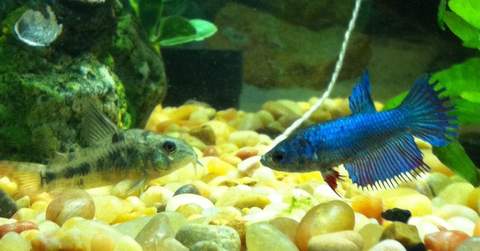
The final and riskiest set of tank mates are going to be school fish like Tetras and Rasboras. The activity level of these fish may actually stress out the more calm Betta. We have to observe their interactions and watch for warning signs. It is very possible to have a Betta that lives happily in a tank with schooling fish.
Bettas are naturally solo fish though. To add tank mates into an aquarium with a Betta is asking the fish to adapt outside of its natural tendencies. Take your time and be patient. Be ready to make changes with your tank mates if things do not work out well for you.
Another thing I forgot to mention in this section is DO NOT place two males in the same tank. Males fighting is where the Bettas got their Siamese Fighting fish came from. Two males will fight to the death in an aquarium. Avoid placing two males in the same aquarium at all costs. There is only one exception – which I cover in this post and is reserved for seasoned aquarists.
Male Bettas will also show aggression to females. It is best if you want multiple Bettas in your aquarium to go female only. Females are not as colorful as males, but a group of 5 females will complement the colors of your tank as they have unique colors and fins in their own right. Keep in mind that a group of female Bettas will require a larger tank and there are really no guarantees of their compatibility as they reach maturity.
Lastly, avoid fish like tiger barbs that enjoy nipping at long fish.
Live Plants

Live plants are a wonderful addition to your Betta to simulate natural habitat. Not only do they add natural hiding places for your Betta, but they are also natural filtration in your aquarium. I recommend live plants for most freshwater setups because they are great for improving water quality. Some plants are also known for being natural water conditioners as they can remove harmful chemicals in your water.
I would highly recommend Low Light Aquarium Plants for your aquarium. Keep in mind that if you do decide to go with live plants, get a Planted Tank LED fixture that can grow plants. I am recommending low-light plants because they are easy to grow and keep. However, many lights that come with starter aquariums will not have the proper light to grow even low-light aquarium plants.
For tanks these small, there is a Finnex FugeRay model that is available that will adequately cover a standard 5-gallon tank. Another option is a Fluval Plant Bluetooth Nano. The Fluval Nano is a perfect light for desktop aquariums.
With one of these lights, you are set to grow just about any low-light aquarium plant you can acquire. For low-light plants here are several you can obtain that would work well in a Betta tank:
Different Types
There is actually a large variety of Betta Fish available for sale in our hobby. For most of the Bettas, you will see that the pet store will not have a specific breed or type listed. There are actually large numbers of available varieties with Bettas. Many have exotic colors and fins. I’m going to talk about several here to show you the vast variety of Bettas available today. If you are shopping online for exotic-style Betta Fish, I would highly recommend that you purchase from a place that offers What You See Is What You Get (WYSIWYG) fish for purchase and from a place that offers you a multiple-day guarantee.
Veil Tail
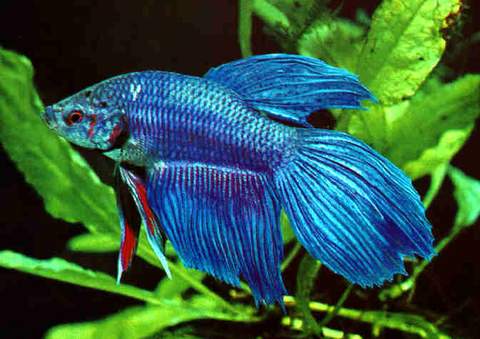
The Veil Tail Betta is the most common Betta you will find at a pet store. They are often labeled as Siamese Fighting Fish at chain pet stores. It is very likely if you are reading this article after you have purchased a Betta yourself that you have a Veil Tail. They are the most widely available Betta in the hobby. After all, this was the original domestic Betta that was brought over to the US. They are also one of the easiest Betta Fish to breed. These Bettas are known for their easy-going nature and are one of the better candidates for a community aquarium.
Half Moon
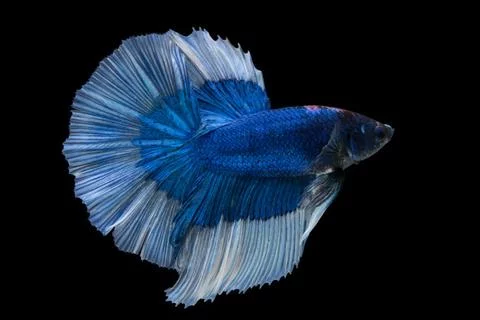
The Half Moon Betta is a Betta that is bred and raised in captivity. It gets its name its tail that spreads 180 degrees to form the half-moon. It is a very striking Betta to have. It is notorious for being a very challenging Betta to breed. They are becoming one of the easier-to-find exotic Betta types nowadays due to their popularity. It was first bred in the 1980s. Half Moon Bettas are also known for their aggressiveness. They are best suited to be solo in an aquarium. Many of the fancier Bettas tend to be only available through local breeders, specialty fish stores, or online.
Rose Tail
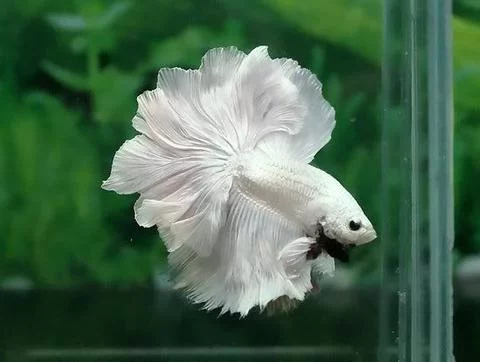
A Rose Tail is a variation of the Half Moon. The ends of their tails are more ruffled creating a striking appearance. As the Half Moon, they are also very difficult to breed. It requires a genetic mutation to occur to get the look and as a result, they tend not to be as hardy as other Betta fish species. They are an amazing-looking Betta
Plakats

Plakats are a short-finned version of the traditional Betta you find in stores. Plakats are the original Betta and very close to the ones you will find in the wild. They are known as the ancestors of all Bettas in the trade today. They tend to be more actively swimming fish over the other fancier varieties and tend to do better in larger tanks as a result. It is actually possible to find a Halfmoon Plakat from a breeder. Given the fact the Plakat Betta is closer to a wild Betta, they tend to be hardier, less prone to injury, and more energetic than fancier Bettas.
Purchasing a fancy Plakat fish is a good balance if you want a fancy Betta, but would prefer a hardier and more active sub-type. The picture above is a Halfmoon Plakat. Another popular variety of Plakat are Koi Bettas.
Elephant Ear
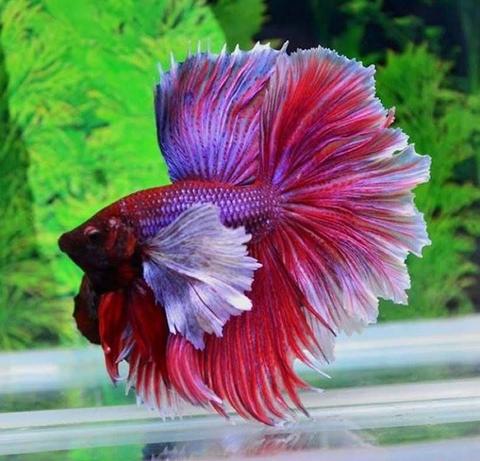
These Bettas get their names from their pectoral fins that look like the ear of an elephant. These are one of the more exotic and striking Betta you will find. These varieties can also be found in the wild (though with less bold colors than their captive-bred varieties). They are aggressive Betta and best suited as a sole specimen. They slow down a lot later in life, so a calm tank alone is the best for them.
Crowntail
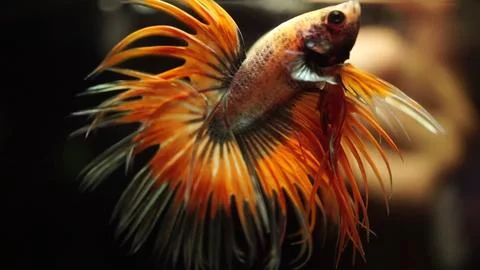
This unique-looking variety has web fins that resemble a crown. It is one of the new varieties among breeders debuting in 1997. This Betta variety produces some of the most exotic colors and mixes available in the trade. Because of its breeding though, this also makes it one of the more difficult Betta to find and take care of. They are more delicate than the other Bettas on the list. It requires exceptionally higher water quality for its fins to stay healthy.
Putting It Together – Creating An Amazing Aquarium
We spent quite a bit of time talking about Bettas, their care requirements, food, and types of Bettas. It’s time to put it all together and built a set up for you. I’m going to use a Fluval Spec V for this build. It is an all-in-one tank with 5 gallons as its volume. The tank really solves a lot of issues for us, namely the filtration and the lighting. The lighting that comes with the unit can grow Low Light Aquarium Plants and the aquarium size is ideal for our Betta. You can use any Aquarium Substrate you want since both Java Fern and Java Moss are water column feeders so either will do fine without an active substrate.
- Tank – Fluval Spec V
- Lighting – Fluval Spec V light is perfect :). No changes are needed!
- Aquarium Filter – Fluval Spec V stock filtration
- Heater – Cobalt NeoTherm
- Hardscape – Coconut Shell or Fluval Driftwood
- Plants – Java Fern and/or Java Moss (Micro Swords and Crypts work as well)
- Substrate – Activ Betta Gems Live Gravel
- A single Male Betta of your choice – Once the tank is cycled!
We can either use a simple aquascape or get fancy with some Driftwood, to ensure it has no sharp edges by sanding down any rough spots. If we go with driftwood, we can attach the moss and ferns to the hardscape with either thread or superglue. Below is a video by Fishaholic showing how to attach Java Fern to driftwood.
Tank Water Quality
Now that you have your Betta tank, you may have questions about water quality. Bettas in general are hardy fish, with fancy sub-types begin to be more sensitive. We want to keep our water quality in good condition when taking care of a Betta. I would recommend doing water changes weekly about 15-20%. You can reduce the water changes if your water quality is high. I always say water changes based on your water parameters. Get used to testing your water conditions every week using a high-quality aquarium water test kit and always use a water conditioner on your tap water.
Some tanks can go bi-monthly or monthly depending on how well the tank is filtered, which your aquarium test kit will hope you monitor when you should make a water change. Check for ammonia, nitrite, and nitrate levels. Ammonia levels and nitrite levels should be at 0 and keep your nitrates below 25.
For pH, Bettas are pretty tolerant of neutral to soft water. They are best with a neutral pH of 7. They will do fine in a slightly acidic pH if accumulated to it, but as close to 7 as possible is ideal.
Maintenance Checklist
Here is a quick maintenance checklist guideline that will help keep your Betta fish happy and to have a long and healthy life.
| Daily | Weekly | Monthly |
| Check water temperature (76 – 81 F) | Change 25-50% water in the tank | Replace filter media or filter cartridge (mechanical and chemical) |
| Observe fish and check for signs of ill health | Siphon out uneaten food and water | Wash media in aquarium water (if reusable) |
| Check equipment to see if it is working (heaters, filtration system, pumps) | Test water parameters | Clean rocks, decor, and/or driftwood |
| Feed your fish | Check plant health and prune overgrowth | |
| Check water levels to see if topping off is needed | Clean off algae from glass |
Additional Resources (Books To Read)
There are some incredible books available about Bettas that go beyond the scope of this blog post. I would encourage you to look into these books and purchase them if you are serious about taking your Betta Fish keeping to another level.
The Betta Bible is the source when it comes to knowledge about Betta Keeping. It is an expensive book, but well worth it. It is loaded with detailed and expert-level information. It has information about the genetics of Bettas, breeding, and the history of the Bettas in our hobby. It is loaded with over 150 pictures of various types of Bettas and the style of writing is very down-to-earth.
The Best Book About Keeping Bettas!
With over 300 pages and written by Ecologist Dr Martin Brammah. This offers one of the best deep dives into the world of Betta care!
Written by Dr. Brammah, this book has been known in the hobby as the book of all books. It’s a must-buy in my opinion. The kindle version is a steal at the price if you can get that. It is everything you would want to know and more about Bettas jammed packed into 300 pages.
The Simple Guide
If the Betta Bible is too much to start with, the Betta Fish book by Walter James is a good alternative. Weighing in at only 124 pages, it is a more digestible deep dive into Betta Fishkeeping.
Where To Buy
Betta fish can be purchased at local fish stores, chain pet stores, and online fish stores. You will usually get the best selection from an online store as they will have many varieties that other stores won’t carry. You can go wrong either way. Bettas tend to ship in good condition due to their hardiness and ability to breathe air outside of the water.
Use Coupon Code ASDFISH at Checkout
Betta Fish are one of the most beautiful varieties of freshwater fish available in the hobby. Easy to care for with plenty of varieties!
FAQS
Are They Easy To Care For?
Yes, Betta fish are one of the easiest freshwater fish to care for. They have a labyrinth organ, which allows them to tolerate smaller spaces and water with high nutrient content. That being said, Betta fish should still have a tank at least 5 gallons in size, a quality filtration unit, heating, and regular feeding and tank cleaning.
Can They Live In Tap Water?
Yes, a Betta fish can live in tap water if you condition the water prior to putting your new fish in your tank. You will want to use a conditioner like Seachem Prime. If you are thinking about using purified water, avoid distilled water or RODI water. You can use that type of water if you use an aquarium materializer, but most aquarists do fine with tap water + a water conditioner when it comes to running a Betta tank.
How Often Should You Change The Water?
If you keep your Betta in an aquarium, you should consider changing your aquarium water every 7-10 days. I know some people do keep Bettas in bowls. If you are keeping them in a bowl, you should consider changing the bowl water every other day.
How Often Should I Feed Them?
You should feed your Betta fish twice per day. Keep in mind, that you need to have the filtration to feed them that much. Test your tank water to see if your levels are stable. If not, you can feed them less. It’s also okay to have a freshwater fish fast for a day every week. Fasting is actually good for their digestive system!
Closing Thoughts
A Betta Fish tank is in my mind the best way to introduce yourself to the wonderful world of aquarium keeping. A Betta tank can be small and low on maintenance making it a lower barrier to entry than other aquarium setups. There are a large variety of Betta breeds and colors. It is difficult to really get bored keeping Betta because there is so much variety and they are loaded with personality. If you have any questions, leave a comment below. Thank you for reading.
- About the Author
- Latest Posts
I’m thrilled that you found Aquarium Store Depot! Here you’ll find information on fish, aquariums, and all things aquatics related. I’m a hobbyist (being doing this since I was 11) and here to help other hobbyists thrive with their aquariums! I adhere to a high quality Editorial Process and Review products with real life field usage and practical analysis.

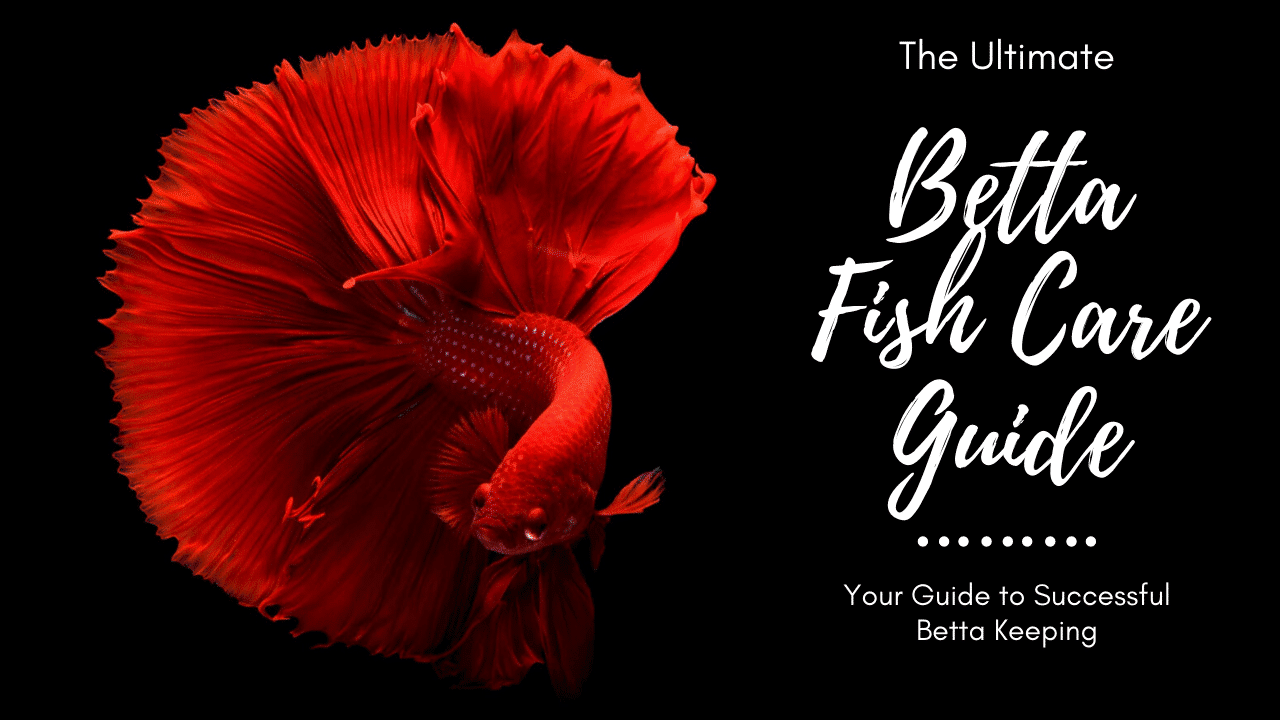

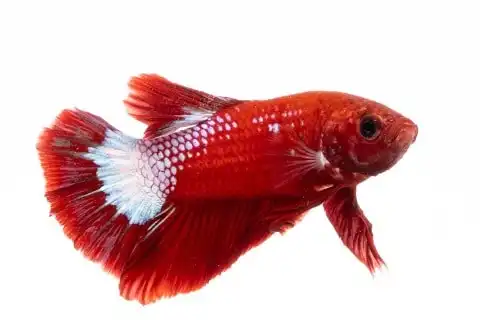




Awesome. I very much like that you point out a 5 gallon minimum.I had my betta friend in a 7 before moving him I to a 15 Gallon tank. He was angry with me and upset for 4 days. Now he swims around through plants and caves all day long, patrolling ‘his’ tank.(And knocking the Ottos of the glass occasionally with his nose.)
He was in a tank with Kuhli Loaches and neocaridina shrimp
and I added a group of Harlekin Rasbora and Otocinclus to the bigger tank.Works very well
It still surprises me how relaxed he is when the rude Kuhli Loaches are having a unresty day. I got him a Koi Female which is in his old tank.He is a Black Dragon Fighter.
This is the best article I’ve ever read for beginner Betta owners, and I’ve done a lot of research. There is so much information out there, that it’s hard to know where to start. I really appreciate your tried and true suggestions on products. Very helpful. Thank you!
Thank you Tricia ^_^. I wish google would think the same sometimes. This article likes to go into the rankings and drop out a lot with their updates. They think I’m not a real person sometimes 😅
My betta was very active would come to the surface everyday to eat everyday. Lately he has been laying on the bottom will only come up for air n hasn’t eaten for 3 days I have not change anything since I got him. Is he sick or getting ready to die I feel so bad don’t know what to do?
Hey Lisa. I have an article about Bettas laying on the bottom of the tank. Check it out – it may provide answers. https://aquariumstoredepot.com/blogs/news/betta-fish-laying-on-bottom-of-tank
I have a question, my Betta is already 3 inches long ( tail excluded ) and suddenly I’ve noticed he’s very hungry . Demanding more food, whatever I give he finishes in less than 30 second. Besides he’s growing, I’ve measured yesterday and he’s grown . He’s with me for around 9 months , I thought he’s fully grown. And he’s making bubble, not the foaming Betta male make for nesting. I’m out of my wits . Is everything all right?
Hi There,
I would take a lot at some bloat and disease articles and see if anything rings a bell for you. From what it looks like, there likely is nothing wrong. Does he have white stringy poop?
Sometimes, but that’s rare . He is very active. I mean he reacts to almost every movement around him. Sometimes even reacts to sound. He moves up and down when my dog goes near him . My concern is he’s extra hungry these days. I feed him only live bloodworm 3 times a day . Yet he acts like he need more and finishes within 30 second. Btw he’s cross between Vail tail and comb tail . Most probably unwanted breeding, because I got him super cheap, 20 rupees ( 25 cents approx ) . But IDC, I am worried about his hunger . I’ve checked for any signs of disease or illness but I think he’s got none.
If his poop is white, that’s why he is hungry all the time, you will need to remove that worm from his body. You will need to use a mix of Seachem focus and metro and dose your food in it. Have him eat this medicated food. It should remove the issue. You will want to feed medicated food for 30 days.
What are your thoughts on using bottled betta water or aquarium water? I have well water that is a high ph (8.2-8.4). Thanks.
Hi Steph,
Bottled water can be used. It’s best to double check with a TDS meter to see what it reads out. Too pure water can be harmful to fish and will require remineralization. That being said, most bottled water will probably be okay. I have an upcoming post on distilled water that will also talk about bottled water. Stay tuned!
Thank you for the article that is given is good and adds insight.
Set the Fluval Spec V up about 3 weeks ago, have two issues:
1) flow rate on the included filter is still too high even set on low. I tried the hack of putting a piece of filter sponge in the nozel but that caused the motor to shut off every three days or so. Don’t want to go to an external filter since part of the value of this unit is the clean look! What to try next?
2) water parameters pH 6.5-6.8, ammonia has spiked and gone down (I used unrinsed stones from the “temporary” betta bowl to seed) but nitrites still 1.5 (per API test kit). Wondering if I should use a few drops of the MicrobeLift gel innoculant I use on my koi pond filters to jump start bacteria?
Hi Leslie,
You can try a courser sponge for the Spec V – like the black ones you usually find in sumps or ponds. For nitrites, it sounds like your tank may not be fully cycled. I’m not familiar with MicrobeLift, but for freshwater tanks I’ve had good success with Fritz Turbostart 700
Thanks for your comment Ria. A pH of 7.0 is ideal for a Betta. I just added it to the post.
What is the best ph balance reading for Beta fish? I’m surprised you don’t have it in your info!